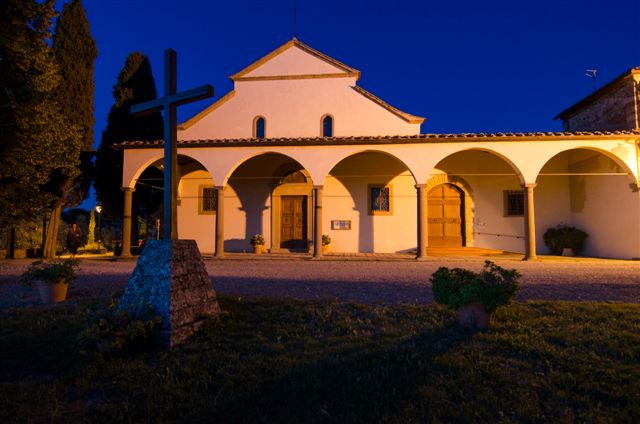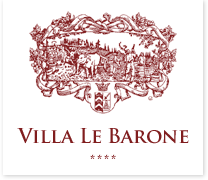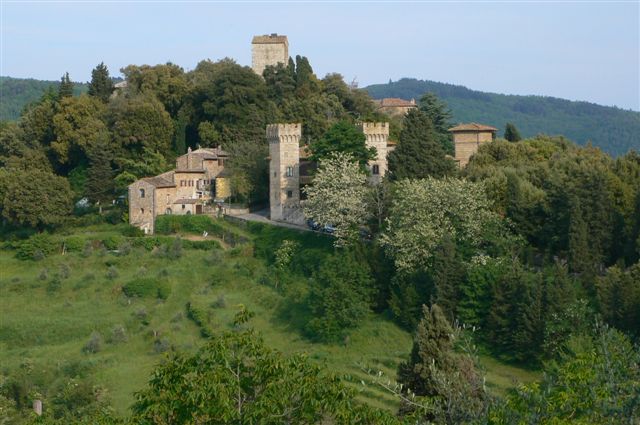Chianti, which includes both parts of Florence and Siena provinces, is renowned for its magnificent landscapes, but also for its castles, churches, villages and hamlets.
Villa le Barone, in Panzano in Chianti, is at the centre of a circle with a 30 minutes drive radius to visit this part of Tuscany: Castellina in Chianti, Monteriggioni, Greve in Chianti, Radda in Chianti…
1 – Castellina in Chianti, built on an Etruscan settlement, is dominated by a 15th century fortress where a rich Etruscan museum has been recently opened. It is a pleasure to stroll on the “ via delle Volte”, a covered middle ages walkway following the ancient walls of the city, to visit the many churches, to discover the many ancient houses…
2 – Volpaia, ( Castello di Volpaia)
 is a fortified hamlet, part of Radda in Chianti, located on a hilltop on the Siena Florence border. Its medieval layout is still intact, with its towers, its vaulted passages, its ancient doors and porches, its church, making Volpaia one of the best preserved villages dating back to the 12th century. Last but not least, there is a typical coffee shop as well as a good winery!
is a fortified hamlet, part of Radda in Chianti, located on a hilltop on the Siena Florence border. Its medieval layout is still intact, with its towers, its vaulted passages, its ancient doors and porches, its church, making Volpaia one of the best preserved villages dating back to the 12th century. Last but not least, there is a typical coffee shop as well as a good winery!
3 – Badia a Coltibuono is a former Benedictine abbey founded in the 11th century and active until the 19th century, when convents were suppressed. It was then transformed in a “Fattoria” (a farm –villa). Badia a Coltibuono is located in a wonderful and suggestive landscape of fir trees. One can admire an impressive Lebanese cedar, 20 m tall and with a trunk with a circumference of 7 m, listed in the Italian Forestry Commission’s census of monumental trees of Tuscany. The church is freely accessible. It is also possible to visit the interior of the abbey, now a private property, and its garden, laid out in the form of the ancient “hortus conclusus”, or “enclosed garden”, with geometrical box hedge divisions around beds planted with aromatic and medicinal plants. It is an important early example of a “Tuscan garden” and -as a monastic garden- it gives a foretaste of the Renaissance villa gardens to come.
4 – Castello di Meleto,( Meleto Castle) built in the 12th century is recognizable from far away by its 2 mighty great circular towers. Belonging to the Benedictines of Coltibuono, it became in the 13th century property of a branch of the Ricasoli family, who enlarged it and turned it in the 18th century a villa-farmhouse you can see today. It is today private property (also a wine making business), but the interior of the castle and its wonderful small internal 18th century theater can be visited.
5 – Radda in Chianti is also a village of Etruscan origins, located on a hilltop. Well preserved, many palaces and churches are worth visiting.
6 – The “Pieve di San Leolino”
 which can be seen from Villa le Barone, is an harmonious Romanesque church, built in the 12th century, with a 16th century portico and a 14th century cloister (inside the church, push open the door on the right). Several important artworks can be admired in the church, such as 2 tabernacles from Giovanni della Robbia, a triptych by Mariotto di Nardo, a 16th century fresco by Raffaellino del Garbo and relics of San Eufrosino who evangelized Chianti.
which can be seen from Villa le Barone, is an harmonious Romanesque church, built in the 12th century, with a 16th century portico and a 14th century cloister (inside the church, push open the door on the right). Several important artworks can be admired in the church, such as 2 tabernacles from Giovanni della Robbia, a triptych by Mariotto di Nardo, a 16th century fresco by Raffaellino del Garbo and relics of San Eufrosino who evangelized Chianti.
7 – The Chianti Sculpture Park, close to Pievasciata, is seven hectares (17 acres) of an untouched wood of ilex and holm oak trees where internationally acclaimed artists from every continent have showcased their imposing contemporary artworks. Every work is site-specific, meaning artists visited the park before creating the works that would be displayed there. This makes the link between art and nature, trees and the works. Even more important, sounds, colors, scents, natural light are a perfect fit for the artworks displayed, thus integrating with and exalting Nature. Artworks are made from the most varied materials: bronze, iron, granite, marble, glass… Along a 1km long itinerary in the forest one can find a labyrinth, a rainbow, a large ship, a musical artwork. Close to the park, in an old kiln, there is also an art gallery.
8 – Montefioralle, on a hill dominating Greve is one of the most ancient medieval villages in Chianti. Enclosed within its original medieval octagonal walls, with four gates, Montefioralle was an important stronghold during the wars between Florence and Siena. It also was during the Middle Ages one of the largest military and administrative centers of the area. A house bearing a V on the front door in the circular main small street of Montefioralle is pointed out as the birth-place of Amerigo Vespucci.
9 – Greve in Chianti, where Villa le Barone is located (in the hamlet of Panzano in Chianti) sits in the valley at the crossing of the roads coming from Florence, Siena and Valdarno. You will like the triangular main piazza, where a market has been running more or less continuously for centuries serving the nearby castle communities and hamlets. The piazza is fronted by numerous medieval buildings, including the 11th century Chiesa Santa Croce. In the middle of the square, stands a statue of the navigator Giovanni da Verrazzano, who discovered the Hudson River and was probably born in the nearby castle bearing his name.
10 – and the many wineries of Chianti Classico. The cultivation of the vine in Chianti dates back to the Etruscans and the Romans and is famous since the 14th century. An edict of Cosimo III de Medici listed Chianti as one of the four Tuscan regions of oenological excellence. A decree of 1932 has delimited to 9 cities (including the cities mentioned above) the area to allowed to produce Chianti. Today, only the Chianti Classico DOCG (controlled and warranted designations of origin) produced in Radda, Gaiole, Castellina and Greve in Chianti can bear the emblem of the Black Rooster. There are many wineries that can be visited in Chianti. Villa le Barone can organize such visits and the best Chianti wines can be chosen to accompany the Tuscan food that is being served in their restaurant.

